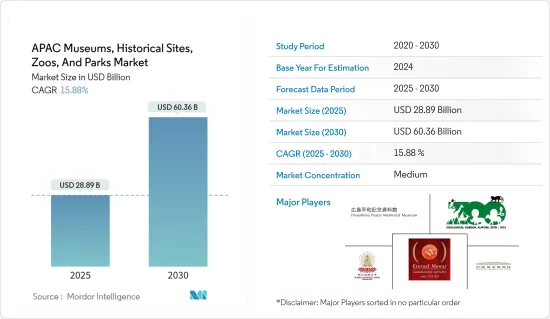PUBLISHER: Mordor Intelligence | PRODUCT CODE: 1644972

PUBLISHER: Mordor Intelligence | PRODUCT CODE: 1644972
APAC Museums, Historical Sites, Zoos, And Parks - Market Share Analysis, Industry Trends & Statistics, Growth Forecasts (2025 - 2030)
The APAC Museums, Historical Sites, Zoos, And Parks Market size is estimated at USD 28.89 billion in 2025, and is expected to reach USD 60.36 billion by 2030, at a CAGR of 15.88% during the forecast period (2025-2030).

The Asia-Pacific region attracts a significant number of domestic and international tourists, driving demand for cultural and recreational attractions such as museums, historical sites, zoos, and parks. The rapid economic development of countries such as China, India and Southeast Asian countries has resulted in a rise in disposable income and spending on leisure activities, boosting the tourism and entertainment sectors.
The rich cultural heritage of many countries in the Asia-Pacific region, including ancient civilizations, historical landmarks, and diverse wildlife, provides a strong foundation for the development of museums, historical sites, zoos, and parks.
Government investment in tourism infrastructure, conservation efforts, and cultural preservation projects plays a significant role in the development and maintenance of museums, historical sites, zoos, and parks. Urbanization trends in the Asia-Pacific region have led to increased demand for recreational spaces and cultural attractions in urban areas, driving the development of museums, parks, and other leisure facilities. Changing demographics, including an aging population and the rise of the middle class, influence visitor demographics and preferences, prompting attractions to adapt their offerings and marketing strategies accordingly.
Overall, the Asia-Pacific market for museums, historical sites, zoos, and parks is characterized by growth opportunities driven by tourism, economic development, cultural heritage, government support, and technological advancements.
APAC Museums, Historical Sites, Zoos, And Parks Market Trends
Rise in the Number of National Parks and Digitalized Experiences is Driving the Market
Asia is a continent where people enjoy this in several ways like trekking and driving. Many museums, zoos, art galleries, and other cultural and art institutions in the Asia Pacific region have implemented digital technologies for better development. Asia Pacific museums adopt digitization, 3D modeling, AR, and virtual reality technologies so visitors can go to the treasures online anytime and anywhere. The Aigner Anna Zoological Park in Chennai was the first in India to start live-streaming animals. It has a live stream of 14 species, including tigers, lions, and hippos. There are 180 cameras installed in the zoo and animal enclosures.
Rise in the Number of Museums and Visitors in China is Driving the Market
China's culture and history is interesting. Almost 24 million people visit the National Museum in Beijing, Shanghai, Nanjing, and Zhejiang. Numerous museums across China have artistic and cultural goods, such as mystery boxes with an archaeological theme. Collectors can dig through some boxes containing a soil sample and a miniature cultural artifact using little shovels and other instruments to attract youth.
APAC Museums, Historical Sites, Zoos, And Parks Industry Overview
The Asia-Pacific museums, historical sites, zoos, and parks market are expected to be concentrated with the presence of a large number of players. Some of the major players present in the market are the Hiroshima Peace Memorial Museum, City Palace Museum Udaipur India, Buddha Tooth Relic Temple and Museum, The Museum of Qin Terra-cotta Warriors and Horses, and the National Museum of China, among others. The market is expected to remain competitive over the forecasted period.
Additional Benefits:
- The market estimate (ME) sheet in Excel format
- 3 months of analyst support
TABLE OF CONTENTS
1 INTRODUCTION
- 1.1 Study Assumptions and Market Definition
- 1.2 Scope of the Study
2 RESEARCH METHODOLOGY
3 EXECUTIVE SUMMARY
4 MARKET DYNAMICS AND INSIGHTS
- 4.1 Market Overview
- 4.2 Market Drivers
- 4.2.1 Growing Popularity of Museums, Historical Sites, Zoos and Park is driving the Market Growth
- 4.2.2 Digitalized Experiences is Driving the Market
- 4.3 Market Restraints
- 4.3.1 Distinct institutional cultures and values
- 4.3.2 Adapting to the changes in technology is tough for the Institutions
- 4.4 Opportunities
- 4.4.1 Use of AI in the Museums, Historical Sites, Zoos, and Park
- 4.4.2 Packaged Tourism with different offers.
- 4.5 Value Chain Analysis
- 4.6 Industry Attractiveness: Porter's Five Forces Analysis
- 4.6.1 Bargaining Power of Buyers
- 4.6.2 Bargaining Power of Suppliers
- 4.6.3 Threat of New Entrants
- 4.6.4 Threat of Substitutes
- 4.6.5 Intensity of Competitive Rivalry
- 4.7 Insights into Technological Advancements in the Industry
- 4.8 Insights on Various Regulatory Trends Shaping the Market
- 4.9 Impact of COVID-19 on the Market
5 MARKET SEGMENTATION
- 5.1 By Type
- 5.1.1 Museums
- 5.1.2 Historical Sites
- 5.1.3 Zoos And Botanical Gardens
- 5.1.4 Nature Parks
- 5.1.5 Other Similar Institutions
- 5.2 By Revenue Source
- 5.2.1 Tickets
- 5.2.2 Food And Beverages
- 5.2.3 Other Revenue Souces
- 5.3 By Country
- 5.3.1 Japan
- 5.3.2 China
- 5.3.3 India
- 5.3.4 Singapore
- 5.3.5 Rest of Asia-Pacific
6 COMPETITIVE LANDSCAPE
- 6.1 Market Concentration Overview
- 6.2 Company Profiles
- 6.2.1 Hiroshima Peace Memorial Museum
- 6.2.2 City Palace Museum Udaipur India
- 6.2.3 Buddha Tooth Relic Temple and Museum
- 6.2.4 The Museum of Qin Terra-cotta Warriors and Horses
- 6.2.5 National Museum of China
- 6.2.6 Arignar Anna Zoological Park, India
- 6.2.7 Sri Venkateswara Zoological Park, India
- 6.2.8 Safari World (Thailand)
- 6.2.9 Singapore Zoo
- 6.2.10 Alipore Zoo in Kolkata, India
- 6.2.11 Surabaya Zoo (Indonesia)
- 6.2.12 Borobudur in Central Java, Indonesia
- 6.2.13 Taj Mahal in Uttar Pradesh, India
- 6.2.14 Great Wall of China in Qinhuangdao/Beijing, China*
7 MARKET FUTURE TRENDS
8 DISCLAIMER AND ABOUT US




